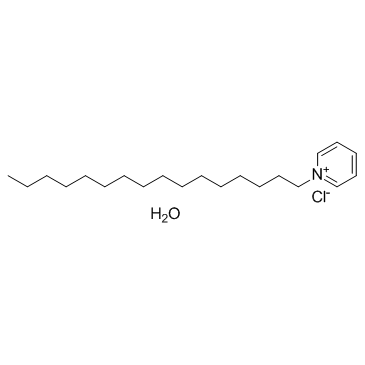6004-24-6
| Name | cetylpyridinium chloride monohydrate |
|---|---|
| Synonyms |
Cetylpyridinum chloride
Cetylpyridinium chloride monohydrate CETYLPYRIDINII CHLORIDUM MFCD00149977 CPC MONOHYDRATE EINECS 204-593-9 Pyridinium, 1-hexadecyl-, chloride, hydrate (1:1:1) cetylpyridinium chloride Chlorohexadecyl pyridine Ceetylpyridiniumchloride 1-Hexadecylpyridin-1-ium chloride hydrate Cetylpyridinium chloride hydrate hexadecylpyridium chloride cetyl pyridium chloride 1-Hexadecylpyridinium chloride hydrate (1:1:1) Halset N-CETYLPYRIDINIUM CHLORIDE MONOHYDRATE Hexadecylpyridinium Chloride Monohydrate Dobendan Sprol 1-cetylpyridin-1-ium chloride hydrate CPC 1-hexadecylpyridinium chloride monohydrate N-hexadecylpyridinium chloride monohydrate CPC hydrate CETYL PYRIDIMUM CHLORIDE |
| Description | Cetylpyridinium chloride monohydrate is a cationic quaternary ammonium compound, used in some types of mouthwashes, toothpastes, throat and nasal sprays, is an antiseptic that kills bacteria and other microorganisms, effective in preventing dental plaque and reducing gingivitis. |
|---|---|
| Related Catalog |
| Melting Point | 81-84 °C |
|---|---|
| Molecular Formula | C21H40ClNO |
| Molecular Weight | 358.001 |
| Exact Mass | 357.279846 |
| PSA | 13.11000 |
| LogP | 3.39510 |
| Stability | Stable. Combustible. Incompatible with strong oxidizing agents, acids, acid anhydrides, acid chlorides. |
CHEMICAL IDENTIFICATION
HEALTH HAZARD DATAACUTE TOXICITY DATA
|
| Symbol |


GHS06, GHS09 |
|---|---|
| Signal Word | Danger |
| Hazard Statements | H301-H315-H319-H330-H335-H410 |
| Precautionary Statements | P260-P304 + P340 + P310-P305 + P351 + P338-P403 + P233 |
| Personal Protective Equipment | Eyeshields;Faceshields;full-face particle respirator type N100 (US);Gloves;respirator cartridge type N100 (US);type P1 (EN143) respirator filter;type P3 (EN 143) respirator cartridges |
| Hazard Codes | T+:Verytoxic; |
| Risk Phrases | R25;R26;R38 |
| Safety Phrases | S28-S36/37-S45-S7/9-S61-S26 |
| RIDADR | UN 2811 6.1/PG 1 |
| WGK Germany | 3 |
| RTECS | UU5075000 |
| Packaging Group | I |
| Hazard Class | 6.1 |
| HS Code | 2933399090 |
| HS Code | 2933399090 |
|---|---|
| Summary | 2933399090. other compounds containing an unfused pyridine ring (whether or not hydrogenated) in the structure. VAT:17.0%. Tax rebate rate:13.0%. . MFN tariff:6.5%. General tariff:20.0% |

